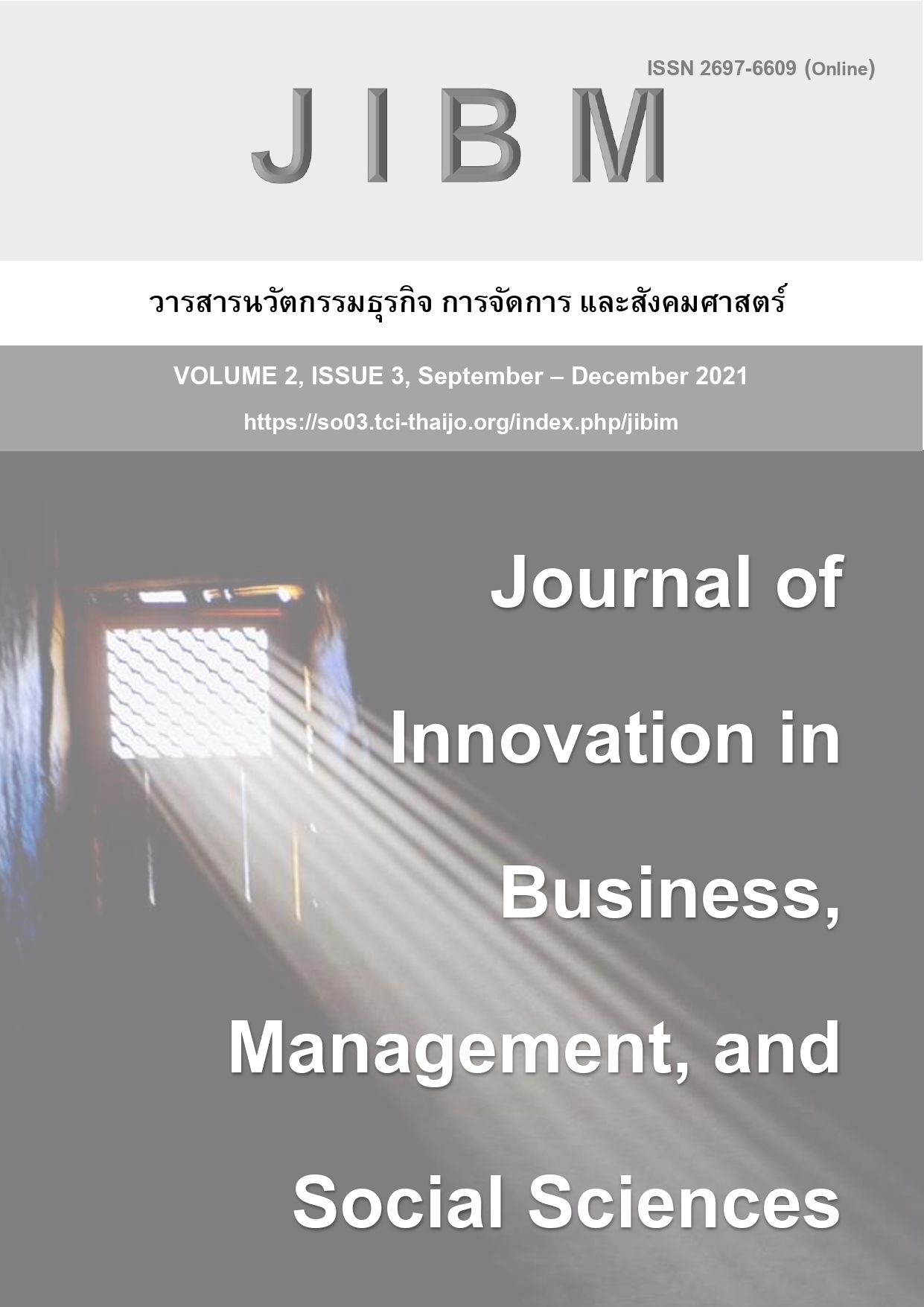DOES MOBILE CELLULAR SUBSCRIPTION ENHANCE ACCESS OF FINANCIAL INCLUSION?
คำสำคัญ:
Financial inclusion, Socioeconomic factors, Electricity, Mobile cellular subscriptionsบทคัดย่อ
This study examines the relationship among account ownership at financial institutions, savings, and borrowings across Asian countries. Electricity and mobile cellular subscriptions are applied to determine whether they enhance access through financial inclusions. A heteroskedasticity probit model is used to examine the relationship of socioeconomic factors against basic financial inclusion factors, electricity consumption, and mobile cellular subscriptions. Thirty-seven countries were tested in 2014 and 2017 with a total sample size of 84,782 adult respondents. Results show that socioeconomic factors vary depending on financial inclusions but not on mobile cellular subscriptions. Mobile cellular subscriptions have been shown to enhance account ownership at financial institutions but do not impact savings and borrowings.
เอกสารอ้างอิง
Alliance for Financial Inclusion. (2020). Digital Financial Services. (AFI, Editor) Retrieved April 4, 2020, from Alliance for Financial Inclusion: https://www.afi-global.org/policy-areas/digital-financial-services
Ando, A., & Modigliani, F. (1963). The "Life Cycle" Hypothesis of Saving: Aggregate Implications and Tests. The American Economic Review, 53 No. 1, Part 1, 55-84. Retrieved from https://www.jstor.org/stable/1817129
Bernasek, A. (2003). Banking on Social Change: Grameen Bank Lending to Women. International Journal of Politics, Culture, and Society: Toward Gender Equity: Policies and Strategies, 16, 369-385. doi:203.150.54.87
Consultative Group to Assist the Poor. (2020). About CGAP. (CGAP, Editor) Retrieved December 14, 2020, from CGAP: https://www.cgap.org/about
Demirguc-Kunt, A., Klapper, L., & Randall, D. (2013). Islamic Finance and Financial Inclusion: Measuring Use of and Demand for Formal Financial Services among Muslim Adults. Development Research Group, Finance and Private Sector Development Team. Washington D.C: The World Bank. Retrieved from https://openknowledge.worldbank.org/handle/10986/16875
Dollar, D., & Gatti, R. (1999). Gender Inequality, Income, and Growth: Are Good Times Good for Women? Policy Research Report on Gender and Development. Washington D.C.: The World Bank Group. Retrieved from https://www.worldcat.org/title/gender-inequality-income-and-growth-are-good-times-good-for-women/oclc/43703722
Fernando, J. (2020). Financial Literacy. Retrieved December 20, 2020, from Investopedia: https://www.investopedia.com/terms/f/financial-literacy.asp
Global Partnership for Financial Inclusion. (2014). Issues Paper Digital Financial Inclusion and the Implications for Customers, Regulators, and Supervisors and the Standard-Setting Bodies. 2nd GPFI Conference on Standard-Setting Bodies and Financial Inclusion: Standard Setting in the Changing Landscape of Digital Financial Inclusion (pp. 17-20). Basel: Global Partnership for Financial Inclusion.
Global Partnership for Financial Inclusion. (2020). About GPFI. (GPFI, Editor) Retrieved April 11, 2020, from Global Partnership for Financial Inclusion: https://www.gpfi.org/about-gpfi
Grameen Bank. (2019). Introduction. Retrieved December 21, 2020, from Grameen Bank: Bank for the Poor: http://www.grameen.com/introduction/
Hirsh, R. F., & Koomey, J. G. (2015). Electricity Consumption and Economic Growth: A New Relationship with Significant Consequences? The Electricity Journal, 28(9), 72-84. doi:http://dx.doi.org/10.1016/j.tej.2015.10.002
Hunter, S., Cruz, V. d., & Dole, D. (2016). Financial Inclusion in the Digital Age. Policy Brief, No. 2016-7. Retrieved from https://www.adb.org/publications/financial-inclusion-digital-age
Kaiser, T., & Menkhoff, L. (2017). Does Financial Education Impact Financial Literacy and Financial Behavior, and If So, When? The World Bank Economic Review, Review 31(3), 611-630. doi:https://doi.org/10.1596/1813-9450-8161
Kenton, W. (2020). Consumption Smoothing. Retrieved December 20, 2020, from Investopedia: https://www.investopedia.com/terms/c/consumption-smoothing.asp
Khandker, S., Khalily, B., & Khan, Z. (1994). Is Grameen Bank Sustainable? Human Resources Development and Operations Policy. Bangladesh: The World Bank Group. Retrieved from https://documents.worldbank.org/en/publication/documents-reports/documentdetail/658601468768006874/is-grameen-bank-sustainable
Klein, M., & Mayer, C. (2011). Mobile Banking and Financial Inclusion: The Regulatory Lessons. Washington, DC: Public-Private Infrastructure Advisory Facility, Financial and Private Sector Development. doi:https://doi.org/10.1596/1813-9450-5664
Komijani, A., & Taghizadeh-Hesary, F. (2018). An Overview of Islamic Banking and Finance in Asia. Tokyo: Asian Development Bank Institute. Retrieved October 15, 2020, from https://www.adb.org/publications/overview-islamic-banking-and-finance-asia
Kunt, A. D., Klapper, L., Singer, D., Ansar, S., & Hess, J. (2018). The Global Findex Database 2017. Washington, DC: The World Bank. Retrieved from https://openknowledge.worldbank.org/handle/10986/29510
Lakner, C., & Milanovic, B. (2013). Global Income Distribution From the Fall of the Berlin Wall to the Great Recession. Washington D.C.: The World Bank. Retrieved from http://documents.worldbank.org/curated/en/914431468162277879/pdf/WPS6719.pdf
Lauer, K., & Lyman, T. (2015). Digital Financial Inclusion. Retrieved March 19, 2020, from CGAP: https://www.cgap.org/research/publication/digital-financial-inclusion
Leyshon, A., & Thrift, N. (1995). Geographies of Financial Exclusion: Financial Abandonment in Britain and the United States. Transactions of the Institute of British Geographers, 20(3), 312-341. doi:194.128.227.202
Meldina Kokorovic, J., & Softic, A. (2016). Comparative Analysis of Financial Inclusion in Developing Regions Around the World. Journal of Economics and Business, 56-65. Retrieved from https://www.econstor.eu/handle/10419/193864
Office of International Religious Freedom. (2018). 2018 Report on International Religious Freedom: Israel: West Bank and Gaza. Retrieved from U.S. Department of State: https://www.state.gov/reports/2018-report-on-international-religious-freedom/israel-west-bank-and-gaza/west-bank-and-gaza/#:~:text=Section%20I.-,Religious%20Demography,territories%20are%20predominantly%20Sunni%20Muslims.
Park, C.-Y. (2018). How Financial Inclusion Reduces Poverty, Income Inequality. Retrieved March 19, 2020, from Asian Development Blog: https://blogs.adb.org/blog/how-financial-inclusion-reduces-poverty-income-inequality
Shinozaki, S. (2017). How Can Digital Finance Better Serve Asia's Poor? Retrieved March 22, 2020, from Asian Development Blog: https://blogs.adb.org/blog/how-can-digital-finance-better-serve-asia-s-poor
Steindl, J. (1989). Money, Credit and Prices in Keynesian Perspective. London: Palgrave Macmillan. doi:https://doi.org/10.1007/978-1-349-20117-4_4
Stenhouse, K., Hanania, J., & Donev, J. (2018). Access to Electricity. Retrieved July 30, 2020, from Energy Education: https://energyeducation.ca/encyclopedia/Access_to_electricity#:~:text=electricity%20%2D%20Energy%20Education-,Access%20to%20electricity,simple%2C%20stable%20access%20to%20electricity.&text=This%20means%20that%20electricity%20access,and%20opportunity%20in%
The World Bank. (2017). The Global Findex Database 2017. Retrieved from Global Findex: https://globalfindex.worldbank.org/node
The World Bank. (2017). The Global Findex Database 2017: About. Retrieved from Global Findex: https://globalfindex.worldbank.org/node
The World Bank. (2018). Financial Inclusion: Financial Inclusion is a Key Enabler to Reducing Poverty and Boosting Prosperity. (T. W. Bank, Editor) Retrieved January 1, 2020, from The World Bank: https://www.worldbank.org/en/topic/financialinclusion/overview
The World Bank. (2020). World Development Indicators. Retrieved December 6, 2020, from The World Bank: https://data.worldbank.org/indicator/IT.CEL.SETS.P2?view=chart
Unique Identification Authority of India - Government of India. (2019). What is Aadhaar. Retrieved November 30, 2020, from Unique Identification Authority of India - Government of India: https://uidai.gov.in/my-aadhaar/about-your-aadhaar.html



